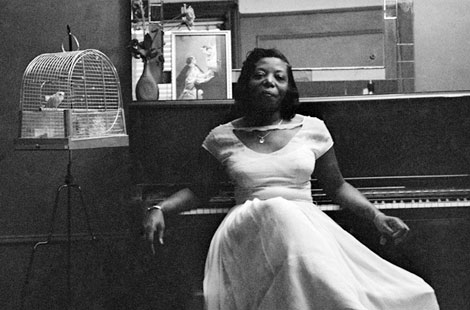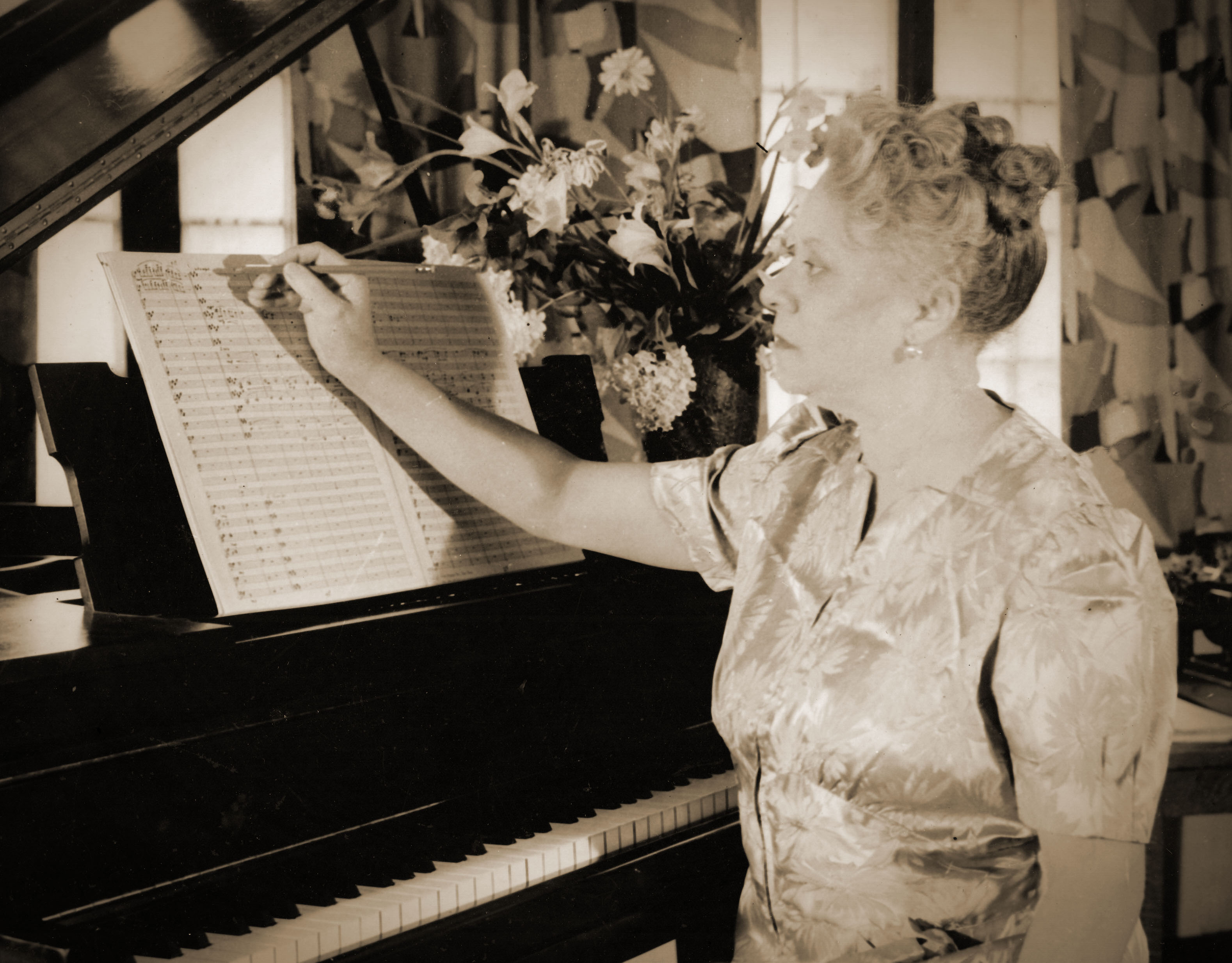
FEATURE image: Paul Laurence Dunbar (1872-1906), African-American poet, standing, at right, in a photograph of the Howard University Class of 1900. William Grant Still extensively used Dunbar’s poetry in his Symphony No. 1 in A-flat, “Afro-American” in 1930.

African American pianist, composer and arranger, and vocalist Mary Lou Williams (1910-1981). She demonstrated remarkable musical talent in modern genres as diverse as classical, free jazz, hard bop, swing, big band, and gospel.
By John P. Walsh
Following the tradition set down by President Jimmy Carter in 1979, the White House officially announced that June 2017 was to be African American Music Month. The proclamation in part reads: “During June, we pay tribute to the contributions African Americans have made and continue to make to American music. The indelible legacy of these musicians who have witnessed our Nation’s greatest achievements, as well as its greatest injustices give all Americans a richer, deeper understanding of American culture. Their creativity has shaped every genre of music, including rock and roll, rhythm and blues, jazz, gospel, hip hop, and rap.” A very nice tribute although I would hasten to attach onto its last sentence – “and all other American musical genres.” This could then include the significant contributions by African American artists to classical music such as William Grant Still (1895-1978), Florence B. Price (1887-1953), Harry T. Burleigh (1866-1949), William Levi Dawson (1899 – 1990), and Mary Lou Williams (1910-1981).
William Grant Still (1895-1978).

William Grant Still (1895-1978) is the “dean” of African-American classical music composers.
Born in Mississippi, William Grant Still grew up in Little Rock, Arkansas, and attended Wilberforce University and Oberlin Conservatory of Music, both in Ohio.
In addition to composing over 150 works— including five symphonies and eight operas— William Grant Still is an African American composer with several musical “firsts” to his name.
He is the first African American composer to conduct a major American symphony orchestra—the Los Angeles Philharmonic Orchestra in 1936.
He is the first to have a symphony performed by a leading orchestra—his Symphony No. 1 in A-flat, “Afro-American” (1930) by the Rochester Philharmonic Orchestra in 1931.
Still’s first symphony (he wrote five) sought to express Black culture within mainly European classical symphonic tools and forms available at that time.
About his intentions for the music, Still wrote: “I seek in the ‘Afro-American Symphony’ to portray not the higher type of colored American, but the sons of the soil, who still retain so many of the traits peculiar to their African forebears; who have not responded completely to the transforming effect of progress.” (see- Catherine Parsons Smith’s William Grant Still: A Study in Contradictions, Berkeley and Los Angeles, CA: University of California Press, 2000, p. 121.)
Arranged in four movements of about 6 minutes each, Still headlined each movement with quotes from poems by early 20th-century African-American poet Paul Laurence Dunbar (1872-1906). In 1899 Dunbar published his Poems of Cabin and Field and died tragically of tuberculosis at 33 years old in 1906. The “Afro-American” Symphony’s 4 movements are entitled: I. Moderato assai (“Longing”); II. Adagio (“Sorrow”); III. Animato (“Humor”) and IV. Lento, con risoluzione (“Aspiration.”)
The stanza by Paul Laurence Dunbar that William Grant Still selected to follow the fourth movement reads:
“Be proud, my Race, in mind and soul,
Thy name is writ on Glory’s scroll
In characters of fire.
High ‘mid the clouds of Fame’s bright sky,
Thy banner’s blazoned folds now fly,
And truth shall lift them higher.”

William Grant Still is the first to have an opera performed by a major opera company—his Troubled Island (1939) by The New York Opera Company in 1949.
Finally, William Grant Still is the first to have an opera performed on national television—his A Bayou Legend (1941) in 1981.
Florence B. Price (1887-1953).

Florence B. Price (1887-1953) is the first African-American female composer to have a major symphonic composition performed by a leading American symphony orchestra. This occurred on June 15, 1933 in Chicago in conjunction with the city’s A Century of Progress International Exposition (Chicago was founded in 1833).
Visitors can still see the Auditorium Theatre on Michigan Avenue where the Chicago Symphony Orchestra performed Price’s Symphony No. 1 in E minor completed in 1932 in a world premiere performance. That historic concert also included musical works by Harry T. Burleigh (main entry below), tenor Roland Hayes (1887-1977), and mixed-race English composer Samuel Coleridge-Taylor (1875-1912) who was known as the “African Mahler.”
Florence B. Price was born in Little Rock, Arkansas into a mixed-race family (her father was a prominent dentist and African American) and later studied at the New England Conservatory of Music in Boston and taught piano, organ and voice at Clark Atlanta University in Georgia as well as privately.
In 1927 she moved to Chicago where in a musical career as a composer that produced over 300 works, her métier blossomed. Price’s music often incorporated rhythms expressed in Africa-based musical traditions and African-American folk tunes and spirituals arranged in elaborate orchestrations derived from the European Romantic composers.
In addition to Symphony No. 1 in E minor (1932), some of Florence B. Price’s best known works include her Fantasie Negre (1929), Mississippi River suite (1934), and Symphony No. 3 in C Minor (1940). In 1940 Florence B. Price was the first female African American composer inducted into the American Society of Composers, Authors and Publishers (ASCAP).
A word on Florence B. Price’s well-known Mississippi River suite (1934): Price composed it in 1934 with a dedication to one of her prominent teachers at the American Conservatory of Music in Chicago where Price continued her musical studies after she arrived to the city in 1927.
The suite uses the contrivance of a boat navigating the Mississippi River and along its path experiencing its diverse expressions of human life and history as told in musical sections.
The FIRST part depicts dawn on the river.
The SECOND part portrays its American Indian heritage by using an array of percussion.
The THIRD part expresses the African American experience along the river utilizing well-known negro spirituals— such as, Nobody Knows the Trouble I’ve Seen; Stand Still Jordan; Go Down, Moses; and Deep River.
The FINAL part has the suite conclude with a melodic cacophony of contemporary tunes during the 1930’s including River Song, Lalotte, and Steamboat Bill.
The Negro Speaks of Rivers by Langston Hughes (1902-1967).

Langston Hughes, who was born in Joplin, Missouri, said he wrote the poem, The Negro Speaks of Rivers, after he was crossing the Mississippi River into Illinois in 1919 and inspiration struck. Even after he helped lead the Harlem Renaissance in New York City as a poet, novelist, and playwright in the 1920’s, Hughes, who grew up in the American Midwest (Kansas, Illinois and Ohio), said he always knew the Heartland best.

William Levi Dawson (1899 – 1990).

William L. Dawson (1899-1990), born in Alabama, was a composer and arranger, trombonist, and music educator. Dawson continually was learning so to use the rich heritage of African American music and later African music as the basis for many types of music that he composed and arranged.
After graduating with highest honors from Tuskegee Institute he studied music and composition in Kansas City and Chicago. For many years he performed as first trombonist with the Chicago Civic Orchestra.
It is Dawson’s work as music director with the 100-voice Tuskegee Institute Choir that led to many distinguished and celebrated national and international choral performances in the mid-twentieth century.
As a composer William Dawson is most famous for his Negro Folk Symphony which he wrote in 1934 but revised in 1952 after studying indigenous African music throughout West Africa. Dawson visited several countries in West Africa that year to study indigenous African music. The experience inspired him to revise his Negro Folk Symphony which was recorded in 1961 by Leopold Stokowski for Decca Records.
The three movements of the symphony are entitled: “The Bond of Africa,” “Hope in the Night” and “O, le’ me shine, shine like a Morning Star!”
William Dawson conducts the Tuskegee Institute Choir in 1955 in his arrangement of the negro spiritual Listen to the Lambs written by R. Nathaniel Dett first performed in 1913.
In 1952, Dawson visited several countries in West Africa to study indigenous African music. The experience inspired him to revise his Negro Folk Symphony which was first written in 1934. The new work was recorded in 1961 by Leopold Stokowski for Decca Records.
Harry T. Burleigh (1866-1949).

Harry Burleigh (1866–1949), born in Erie, Pennsylvania, was an eminent African-American baritone, and influential classical composer and arranger.
As a student at New York City’s National Conservatory of Music of America, Burleigh became associated with Antonín Dvořák (1841-1904) who heard the baritone sing spirituals and encouraged him to create arrangements for these melodies.
With the Czech composer’s active interest, Burleigh developed into one of America’s most important composers and arrangers of spirituals. He created arrangements for more than 100 songs including “Deep River,” “Swing Low, Sweet Chariot,” and “Nobody Knows the Trouble I’ve Seen” which are classics today. Burleigh’s “In Christ there is no East or West” remains a church hymnal standard. Burleigh set poems by Walt Whitman to music also.
When Burleigh was accepted in 1894 as baritone soloist at St. George’s Episcopal Church in Manhattan—a post where he stayed for over 50 years—it was by a vote of the congregation which had never allowed African-Americans to worship there before. The congregation voted to a tie—that was broken in Harry Burleigh’s favor by congregant by J. P. Morgan.
While Burleigh’s advocacy of negro melodies through writing, speaking engagements and new arrangements was always indefatigable, he found time to coach many well-known singers, including Enrico Caruso, Roland Hayes, Marion Anderson, and Paul Robeson.
Mary Lou Williams (1910-1981).

A self-taught pianist, by the time she was 20 years old Mary Lou Williams was a professional musician and touring bandleader.
In her formative years she looked for inspiration to Chicago bandleader and composer “Lovie” Austin (1887–1972). Quite soon Williams’ own records as a pianist and arranger began to sell briskly.
In a 50-year-plus career she wrote and arranged music for bandleaders such as Duke Ellington (1899-1974) and Benny Goodman (1909-1986) and served the beloved mentor to slightly younger African-American musical artists who became household names in the world of jazz: Thelonious Monk (1917-1982), Charlie Parker (1920-1955), Miles Davis (1926-1991), Tadd Dameron (1917-1965), Bud Powell (1924-1966), and Dizzy Gillespie (1917-1993), to name a few.
Though Mary Lou Williams’ musical accomplsihments are not well-known in popular culture, almost 40 years after her death, her recordings are a treasure to listen to and she is much honored for her inspiring work by her admirers—many of whom are artists and great institutions.
Mary Lou Williams’ album, Zodiac Suite, released in 1945 and remastered here from the original acetates, is a 12-part interpretation of the astrological zodiac composed and performed on the piano by Mary Lou Williams who is accompanied by two of her hand-picked session musicians—all innovators from the clubs of New York—namely, Canadian jazz double-bassist Al Lucas (1912-1983) and American jazz and rhythm & blues drummer Jack “The Bear” Parker.
Each movement is a set of classically-inspired jazz tone poems for the signs of the horoscope: Aries, Taurus, Gemini, Cancer, Leo, Virgo, Libra, Scorpio, Sagittarius, Capricorn, Aquarius, and Pisces.





